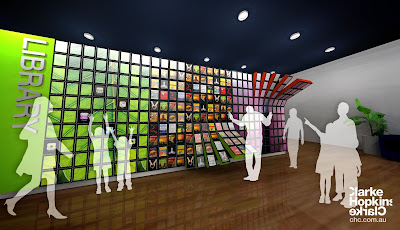Stack iPads for Library e-Book Display
 According to Gizmodo, architects Clarke Hopkins Clarke have suggested stacking hundreds of Apple iPads on a library wall to display iBooks. A wall of iPads in a library is an intriguing idea, but would cost twenty times as much as some alternatives. There are much more affordable and environmentally efficient ways to build a video wall to display e-Books.
According to Gizmodo, architects Clarke Hopkins Clarke have suggested stacking hundreds of Apple iPads on a library wall to display iBooks. A wall of iPads in a library is an intriguing idea, but would cost twenty times as much as some alternatives. There are much more affordable and environmentally efficient ways to build a video wall to display e-Books.Many libraries now use large flat panel displays. These can be used to show book details. The latest of these displays used LED backlit LCD panels, which use less power than old plasma screens. One computer can drive many displays, making the setup much cheaper. A video projector can also be used to make a wall size display which can show one large image, or well as many small ones. At the Australian National University's famous " CSIT building N101 seminar room" I have used the full wall display for presentations. Three high resolution projectors cover one wall of the room and a computer with three video interfaces knits these into one large desktop. The wall has also been used for video art display. The wall can display cinema style video, or when the room is needed for other purposes, simply switched off.
An Apple iPad has an area of about 0.05m2 and costs about US$500. The Dell G2410 24-inch LED LCD monitor has an area of 0.23m2 and costs about US$300. Allowing for the extra computer hardware to drive a video wall, the LCD screens would cost about US$500 each. These would cost the same as the iPads, but because the iPads are much smaller the wall would cost five times as much.
The wall depicted by Clarke Hopkins Clarke has thirty columns of iPads, ten high, or 300 in total. The wall would cover 15m2 and the iPads would cost US$150,000. The same wall area would require about 66 LCD screens and cost US$33,000. Using video projectors would cost about US$7,000.
Labels: ANU CIST N101, ANU School of Computer Science, Apple iPad, digital signage, Libraries, video wall


